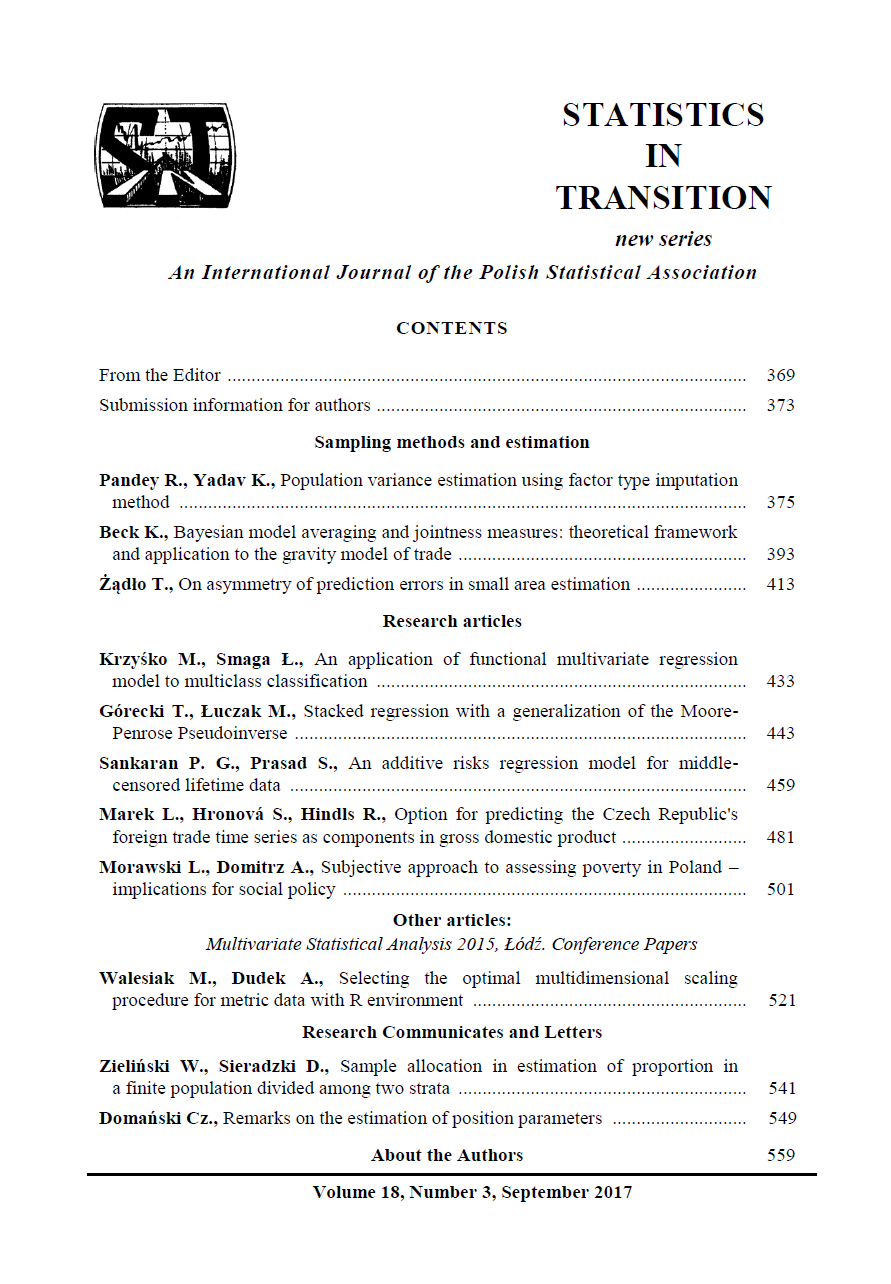ARTICLE
ABSTRACT
Middle-censoring refers to data arising in situations where the exact lifetime of study subjects becomes unobservable if it happens to fall in a random censoring interval. In the present paper we propose a semiparametric additive risks regression model for analysing middle-censored lifetime data arising from an unknown population. We estimate the regression parameters and the unknown baseline survival function by two different methods. The first method uses the martingale-based theory and the second method is an iterative method. We report simulation studies to assess the finite sample behaviour of the estimators. Then, we illustrate the utility of the model with a real life data set. The paper ends with a conclusion
KEYWORDS
additive risks model, counting process, martingales, middle-censoring
REFERENCES
Aalen, O. O. (1980). A model for nonparametric regression analysis of counting processes. Mathematical Statistics and Probability Theory, 1–25.
Aalen, O. O. (1989). A linear regression model for the analysis of life times. Statis tics in Medicine, 8(8), 907–925.
Andersen, P. K., Borgan, O., Gill, R. D., & Keiding, N. (2012). Statistical Models based on Counting Processes. Springer Science & Business Media.
Andersen, P. K. & Gill, R. D. (1982). Cox’s regression model for counting pro cesses: a large sample study. The annals of statistics, 1100–1120.
Aranda-Ordaz, F. J. (1983). An extension of the proportional-hazards model for grouped data. Biometrics, 109–117.
Bennett, N., Iyer, S. K., & Jammalamadaka, S. R. (2017). Analysis of gamma and Weibull lifetime data under a general censoring scheme and in the presence of covariates. Communications in Statistics - Theory and Methods, 46(5), 2277–2289.
Breslow, N. & Day, N. (1980). Conditional logistic regression for matched sets.Statistical Methods in Cancer Research, 1, 248–279.
Breslow, N. E. (1972). Discussion of paper of D. R. Cox. Journal of Royal Statisti cal Society Series B, 34, 216–7.
Breslow, N. E. & Day, N. E. (1987). Statistical Methods in Cancer Research, vol ume 2. International Agency for Research on Cancer, Lyon.
Cox, D. R. (1972). Regression models and life tables (with discussion). Journal of the Royal Statistical Society, 34, 187–220.
Cox, D. R. (1975). Partial likelihood. Biometrika, 62(2), 269–276.
Cox, D. R. & Oakes, D. (1984). Analysis of Survival Data, volume 21. CRC Press.
Cox, D. R. & Snell, E. J. (1968). A general definition of residuals. Journal of the Royal Statistical Society. Series B (Methodological), 248–275.
Davarzani, N. & Parsian, A. (2011). Statistical inference for discrete middle censored data. Journal of Statistical Planning and Inference, 141(4), 1455–1462.
Davarzani, N., Parsian, A., & Peeters, R. (2015). Statistical inference on middle censored data in a dependent setup. Journal of Statistical Theory and Practice,9(3), 646–657.
Huang, J. & Wellner, J. A. (1995). Efficient estimation for the proportional hazards model with "case 2" interval censoring. Technical Report No. 290, Department of Statistics, University of Washington, Seattle, USA.
Ichida, J., Wassell, J., Keller, M., & Ayers, L. (1993). Evaluation of protocol change in burn-care management using the Cox proportional hazards model with time dependent covariates. Statistics in Medicine, 12(3-4), 301–310.
Iyer, S. K., Jammalamadaka, S. R., & Kundu, D. (2008). Analysis of middle censored data with exponential lifetime distributions. Journal of Statistical Plan ning and Inference, 138(11), 3550–3560.
Jammalamadaka, S. R. & Iyer, S. K. (2004). Approximate self consistency for middle-censored data. Journal of Statistical Planning and Inference, 124(1), 75–86.
Jammalamadaka, S. R. & Leong, E. (2015). Analysis of discrete lifetime data under middle-censoring and in the presence of covariates. Journal of Applied Statistics,42(4), 905–913.
Jammalamadaka, S. R. & Mangalam, V. (2003). Nonparametric estimation for middle-censored data. Journal of Nonparametric Statistics, 15(2), 253–265.
Jammalamadaka, S. R. & Mangalam, V. (2009). A general censoring scheme for circular data. Statistical Methodology, 6(3), 280–289.
Jammalamadaka, S. R., Prasad, S. N., & Sankaran, P. G. (2016). A semi-parametric regression model for analysis of middle censored lifetime data. Statistica, 76(1),27.
Kalbfleisch, J. D. & Prentice, R. L. (2011). The Statistical Analysis of Failure Time Data, volume 360. John Wiley & Sons.
Klein, J. P. & Moeschberger, M. L. (2005). Survival Analysis: Techniques for Cen sored and Truncated Data. Springer Science & Business Media.
Lawless, J. F. (2011). Statistical Models and Methods for Lifetime Data, volume 362. John Wiley & Sons.
Lin, D. & Ying, Z. (1994). Semiparametric analysis of the additive risks model. Biometrika, 81(1), 61–71.
Mangalam, V., Nair, G. M., & Zhao, Y. (2008). On computation of NPMLE for middle-censored data. Statistics & Probability Letters, 78(12), 1452–1458.
Sankaran, P. G. & Prasad, S. (2014). Weibull regression model for analysis of middle-censored lifetime data. Journal of Statistics and Management Systems,17(5-6), 433–443.
Shen, P. (2010). An inverse-probability-weighted approach to the estimation of distribution function with middle-censored data. Journal of Statistical Planning and Inference, 140(7), 1844–1851.
Shen, P. (2011). The nonparametric maximum likelihood estimator for middle censored data. Journal of Statistical Planning and Inference, 141(7), 2494–2499.
Sun, J. (2006). The Statistical Analysis of Interval-censored Failure Time Data.Springer Science & Business Media.
Tarpey, T. & Flury, B. (1996). Self-consistency: a fundamental concept in statistics.Statistical Science, 229–243.
Thomas, D. C. (1986). Use of auxiliary information in fitting nonproportional haz ards models. Modern Statistical Methods in Chronic Disease Epidemiology, 197–210.
Wang, P., Tong, X., Zhao, S., & Sun, J. (2015). Regression analysis of left-truncated and case I interval-censored data with the additive hazards model. Communica tions in Statistics - Theory and Methods, 44(8), 1537–1551.
Yu, Q., Wong, G. Y., & Li, L. (2001). Asymptotic properties of self-consistent estimators with mixed interval-censored data. Annals of the Institute of Statistical Mathematics, 53(3), 469–486
